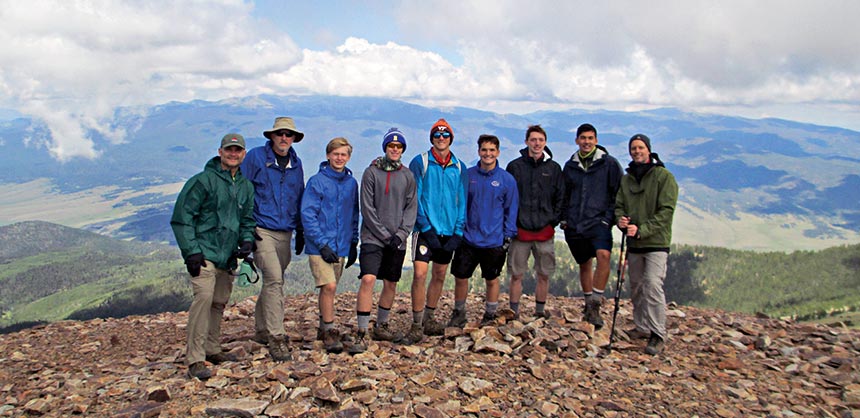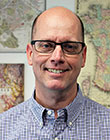Taking the Road Less TraveledNovember 1, 2017
Volunteering Leads to the Trip of a Lifetime By Joe MargrafTaking the Road Less Traveled
Volunteering Leads to the Trip of a Lifetime
Margraf and his Scout crew at the 12,441-foot summit of Baldy Mountain. Credit: Joe Margraf
 Joe Margraf is a professional meetings executive with 30 years of extensive experience in managing all levels of the meetings and hospitality industry. He currently heads up the meetings and events division at Omega World Travel in Fairfax, Virginia. Joe enjoys problem-solving, implementing of solutions, producing in fast-paced and high-pressure environments in the meetings world. He has worked with major association clients, international unions and major corporations.
Joe Margraf is a professional meetings executive with 30 years of extensive experience in managing all levels of the meetings and hospitality industry. He currently heads up the meetings and events division at Omega World Travel in Fairfax, Virginia. Joe enjoys problem-solving, implementing of solutions, producing in fast-paced and high-pressure environments in the meetings world. He has worked with major association clients, international unions and major corporations.
Corporate and association meeting planners always remember that one special meeting or event that stands out from the hundreds of others they have worked on over their career. It is even more rare when a planner can tie in a volunteer organization he or she is involved in with a successful event. That is exactly what I was able to achieve this past summer.
I am the manager of the Meetings, Incentives, Conferences & Events (MICE) Division for Omega World Travel in Fairfax, Virginia. But in my spare time, I am the Scoutmaster for the Boy Scouts of America Troop 1346 in Burke, Virginia. On July 24th, I led a group of 21 Boy Scouts and seven leaders on a 100-mile trek through northeastern New Mexico. The group spent 12 days hiking the New Mexico wilderness on a visit to Philmont Scout Ranch. Located in Cimarron, New Mexico, the 214-square-mile ranch is in the rugged wilderness of the Sangre de Cristo Mountains and features trails climbing from 6,500 feet to 12,441 feet.
Once-in-a-Lifetime Trip
These trips are a once-in-a-lifetime opportunity for Boy Scouts and their leaders, and the preparation for them starts over a year-and-a-half in advance. The adult leaders handle all the logistics associated with each trip. In fact, I had planned two past trips to Canada and the Bahamas, but this one was longer with triple the number of participants. Last fall, I had just started working at Omega World Travel and decided to approach my director about having Omega help with the Boy Scout trip.
My meeting team at Omega was able to assemble several detailed proposals for the BSA group to consider. Omega incorporated and negotiated fairly priced air, ground transportation and hotel options for the Boy Scout crew. Because the Scouts and leaders need to acclimate to the high altitude of the area, Omega suggested two cities for the Scouts to tour prior to their arrival at Philmont Scout Ranch: Denver/Colorado Springs or Albuquerque. Both cities were above 5,000 feet, allowing for good acclimation. Omega’s meetings division extensively researched the local areas of both cities to provide numerous activity options for the group during those two days. The Scouts ultimately voted to fly into Denver and spend two nights in Colorado Springs. While there, they visited the Garden of Gods, the U.S. Air Force Academy, the Cogwheel Railway to Pikes Peak and the U.S. Olympic Training Center. It was the perfect pre-trip before beginning the intense journey at Philmont. With a major part of the planning out of the way, the Scouts and leaders were now able to focus on the intense training required for their trek.
High-altitude Adventure
Since the Boy Scout crew is boy-led — meaning the adult advisors are only there for guidance and safety — my 16-year-old son, Nick, was the crew chief for his group during the Philmont trek. It was his responsibility to handle all aspects of the hike. Each participant had to carry a 40- 50-pound backpack containing all of their supplies, including: tents, first-aid supplies, clothing, camp stoves and freeze-dried meals while hiking between camps. The hikes were at a very high altitude in bear and mountain lion territory, up and down steep climbs (switchbacks) and often during severe rain storms. The crew never passed a house or town along their journey, and only stopped for a short time every few days at bear-proof “commissaries” to grab more necessities. One of the most difficult yet highly anticipated parts of the trip was the climb to the summit of Baldy Mountain (12,441 feet.)
While on the trail, the Scouts participated in backcountry programs including rock climbing, building railroad track, black-powder shooting, hatchet throwing, blacksmithing, Western campfires as well as a conservation project centered on the upkeep of Philmont’s ecosystem. Cellphones were limited to the leaders; however, service was only available at the highest peaks or openings, with nowhere for charging. I had all the Scouts leave their phones behind and I, too, followed their example. So instead of the Scouts being on their phones, they all needed to hang daily bear bags, cook and clean in the backcountry, and set up tents before almost daily fast-moving mountain storms crept in during the early afternoons.
This was truly a once-in-a-lifetime experience, and I am so glad I was able to complete the trek with my Scouts, fellow leaders and most importantly, my younger son, Nick. It was his leadership and daily encouragement that helped me immensely while on the trail.
This trip was a personal goal of mine, but there was a bigger reason. I feel that giving back to my son, my Philmont crew and my Boy Scout Troop was so much more rewarding. Watching, guiding and mentoring these young men not only to complete this difficult trek but having them work together in difficult circumstances is a lesson they will use for the rest of their lives. If these Scouts and all my other Scouts only take this one lesson from their entire Scouting experience, then I feel I have helped out in a small way to make the world a better place. AC&F










